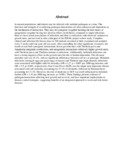Good and bad co-infections; impact on growth and survival of zebu cattle under one year

View/
Date
2012Author
Thumbi `, SM
Poole J, Kiara H
Jennings A, Handel I, Bronsvoort MB Toye P3
Coetzer, J
Conradie, I
Woolhouse, MEJ
Metadata
Show full item recordAbstract
In natural populations, individuals may be infected with multiple pathogens at a time. The direction
and strength of co-infecting pathogen interactions are often unknown and dependent on the
mechanism of interaction. They may be synergistic (together harming the host more) or antagonistic
(together having less adverse effects on the host), compared to single infections. Here we have tested
associations of infections and their co-infections with observed variation in growth rates, and survival
in zebu cattle part of the IDEAL project cohort study. Complete clinical and infection life history
data on 548 animals recruited at birth, examined and sampled every 5 weeks until one year old was
used. After controlling for other significant covariates, the results reveal both synergistic interactions
(lower growth rates) with Theileria parva and Anaplasma marginale coinfections, and antagonistic
interactions (relatively higher growth rates) with Theileria parva and Theileria mutans co-infections.
Additionally, helminth infections can have a strong negative effect on the growth rates but this is
burden-dependent. The all-cause mortality rate was 16.1%, with no significant differences between
calf sex or genotype. Helminth infections (strongyle eggs per gram (epg) of faeces) and Theileria
spps high-intensity infections were associated with higher odds for mortality (OR =1.27, p < 0.001
per 1000 epg increase, and OR = 5.5, p< 0.001, respectively). East Coast Fever (ECF) was the single
most important disease associated with calf mortality accounting for 37.1% of all deaths, followed
by Haemonchosis accounting for 11.2%. However, the risk of death due to ECF was itself influenced
by helminth burden (OR = 1.41 per 1000 epg increase, p< 0.001). These findings present evidence of
pathogen interactions affecting host growth and survival, and have important implications on disease
control strategies, suggesting benefits of an integrated approach to worm and tick-borne diseases
